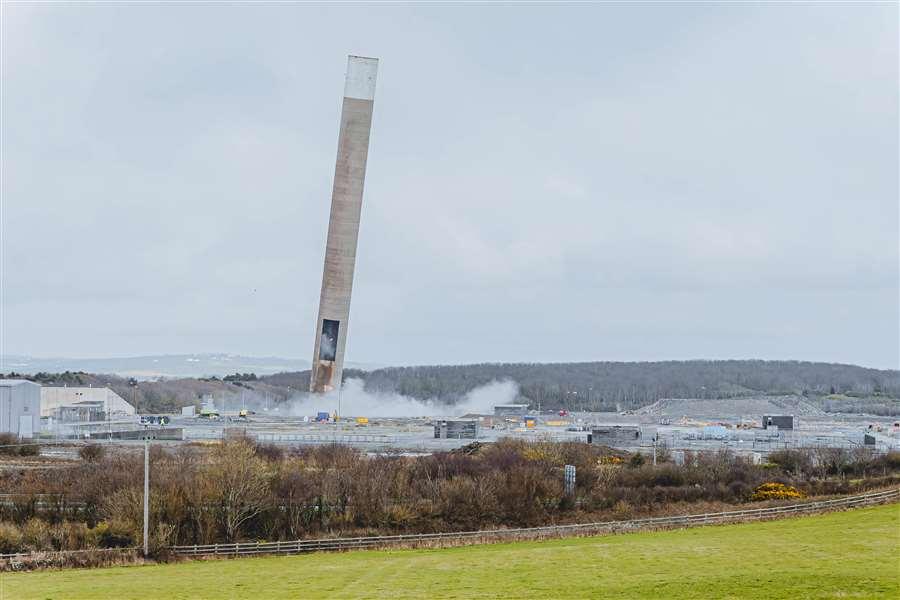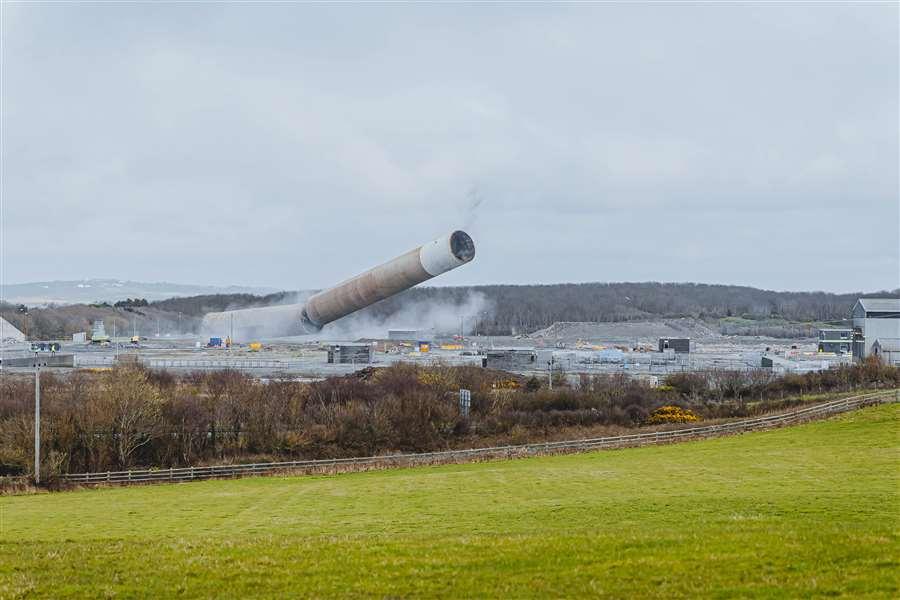R.E.News International-Total Reclaims downs 122-m Holyhead chimney stack
 04/04/24-FR-English-NL-footer
04/04/24-FR-English-NL-footer
Total Reclaims abat une cheminée Holyhead de 122 m

 (PHOTO: Total Reclaims Demolition)
(PHOTO: Total Reclaims Demolition)
Total Reclaims Demolition (TRD) a fait tomber une cheminée de 122 mètres de haut dans l'ancienne fonderie d'aluminium d'Anglesey, près de Holyhead, Anglesey, au Royaume-Uni.
Anglesey Aluminum a été fermé en 2013, après avoir produit environ 140 000 tonnes d'aluminium chaque année depuis 1971. Au plus fort de ses opérations, le site était « le plus grand consommateur d'électricité » au Royaume-Uni, utilisant environ 255 mégawatts par an.
Sa cheminée en béton, un monument local qui se trouvait dans l'usine depuis plus de 50 ans et qui était auparavant l'une des structures les plus hautes du Pays de Galles, a été démontée le 20 mars via un événement explosif contrôlé.
TRD a renversé la cheminée, qui était renforcée par un conduit interne en acier, en affaiblissant au préalable la structure.
TRD a déclaré : « En raison de la hauteur de la cheminée, elle a été construite avec une quantité importante de renforts et, pour que la trajectoire de la cheminée soit prédite avec précision, une grande partie du renfort a été découpée sur la face nord-ouest.
"Cela, ainsi que l'emplacement des ouvertures existantes dans la base de la cheminée, qui formaient commodément les "charnières", déterminaient l'angle de chute de la cheminée et son lieu de repos ultérieur."
L'entrepreneur en démolition a également aménagé une fenêtre dans la face sud-est de la cheminée, dans le sens de la chute. et 156 trous ont été forés au diamant selon un modèle défini.
Il a ensuite utilisé un total de 20 kg de TNT pour effectuer l'abattage, avec des charges de 125 grammes emballées dans 156 trous individuels forés au diamant selon un schéma défini.
"Ces charges ont été injectées et reliées via environ 120 m de cordon dénotant à un point central au bas de la cheminée", a déclaré TRD.
La cheminée abattue quelques instants avant de toucher le sol (PHOTO : Total Reclaims Demolition)
Selon l'entrepreneur en démolition, la proximité de l'espace aérien de la RAF, des lignes de passagers et de marchandises adjacentes de Network Rail et la fermeture temporaire requise de deux artères routières principales à proximité, signifiaient qu'il ne disposait que d'une « fenêtre d'opportunité de 15 minutes » pour commencer les travaux. souffler.
S'exprimant au nom de Total Reclaims Demolition, Stephen Fisher a déclaré : « La journée s'est déroulée parfaitement comme prévu, et c'est grâce à toute l'équipe qui était non seulement présente ce jour-là, mais aussi à tous ceux qui ont aidé à sa planification. »
L'explosion était le point culminant de 15 semaines de travaux préparatoires.
Dans le cadre de son contrat avec Stena Line, TRD a également dégagé les fonderies restantes et quatre hangars de stockage du site.
"Les quatre hangars de stockage et les fonderies étaient principalement constitués de portiques en acier recouverts d'aluminium", a déclaré TRD.
« Les hangars étaient des travaux de type usine. Pourtant, avec 480 m de long et 22 m de large, ils étaient vastes, générant environ 6 000 tonnes de ferraille et de métaux non ferreux.
NJC.© Info Total Reclaims Démolition (TRD)
--------------------------------------------------------------------------------------------------------------------
 04/04/24-English
04/04/24-English
Total Reclaims downs 122-m Holyhead chimney stack

 (PHOTO: Total Reclaims Demolition)
(PHOTO: Total Reclaims Demolition)
Total Reclaims Demolition (TRD) has brought down a 122-metre-high chimney at the retired Anglesey Aluminium smelting plant near Holyhead, Anglesey, in the United Kingdom.
Anglesey Aluminium was closed in 2013, having produced around 140,000 tonnes of aluminium every year since 1971. At the height of its operations, the site was “the biggest single user of electricity” in United Kingdom, utilising around 255 Mega Watts per annum.
Its concrete chimney - a local landmark that had stood at the plant for over 50 years and was previously one of the tallest structures in Wales, was taken down on 20 March via controlled explosive event.
TRD toppled the chimney, which was reinforced with an internal steel flue, by first pre-weakening the structure.
TRD said: “Due to the height of the chimney, it was constructed with a significant amount of reinforcement and, for the chimney’s trajectory to be accurately predicted, a large section of the reinforcement was cut on the northwest face.
“This along with the locations of the existing openings within the chimney’s base, which conveniently formed the “hinges” determined the angle that the chimney would fall and its subsequent resting place.”
The demolition contractor also formed a window in the southeast face of the chimney, in the direction of fall. and 156 holes were diamond drilled in a set pattern.
It then used a total of 20 kg of TNT to carry out the felling, with 125-gram charges packed into 156 individual diamond-drilled holes in a set pattern.
“These charges were grouted and connected via approximately 120 m of denotating cord back to a central point at the bottom of the chimney,” said TRD.
The felled chimney moments before it hit the ground (PHOTO: Total Reclaims Demolition)
According to the demolition contractor, the close proximity of RAF air space, adjacent Network Rail passenger and freight lines and the required temporary closure of two nearby major road arteries, meant that it had only “a 15-minute window of opportunity” to commence the blowdown.
Speaking on behalf of Total Reclaims Demolition, Stephen Fisher, said: “The day went perfectly as planned, and it was with thanks to the entire team that was not only present on the day, but all those that assisted in the planning of it.”
The blast was the culmination of 15 weeks of enabling works.
As part of its contract with Stena Line, TRD also cleared the site’s remaining smelting works and four storage sheds.
“The four storage sheds and smelting works were primarily steel portal frames, clad in aluminium,” said TRD.
“The sheds were run of the mill type of work. Although, at 480m long and 22m wide they were vast, generating around 6000 tonnes of scrap ferrous and non-ferrous metal.”
NJC.© Info Total Reclaims Demolition (TRD)
--------------------------------------------------------------------------------------------------------------------
 04/04/24-NL
04/04/24-NL
Totale terugwinning vernietigt de Holyhead-schoorsteen van 122 m

 (PHOTO: Total Reclaims Demolition)
(PHOTO: Total Reclaims Demolition)
Total Reclaims Demolition (TRD) heeft een 122 meter hoge schoorsteen neergehaald in de gepensioneerde aluminiumsmelterij van Anglesey nabij Holyhead, Anglesey, in het Verenigd Koninkrijk.
Anglesey Aluminium werd in 2013 gesloten, nadat er sinds 1971 jaarlijks ongeveer 140.000 ton aluminium werd geproduceerd. Op het hoogtepunt van de activiteiten was de locatie “de grootste elektriciteitsverbruiker” in Groot-Brittannië, met een verbruik van ongeveer 255 megawatt per jaar.
De betonnen schoorsteen, een plaatselijk herkenningspunt dat al meer dan 50 jaar bij de fabriek stond en voorheen een van de hoogste bouwwerken in Wales was, werd op 20 maart door middel van gecontroleerde explosieven afgebroken.
TRD liet de schoorsteen vallen, die was versterkt met een intern stalen rookkanaal, door eerst de structuur vooraf te verzwakken.
TRD zei: “Vanwege de hoogte van de schoorsteen werd deze gebouwd met een aanzienlijke hoeveelheid wapening en om het traject van de schoorsteen nauwkeurig te kunnen voorspellen, werd een groot deel van de wapening aan de noordwestkant doorgesneden.
“Dit, samen met de locaties van de bestaande openingen in de basis van de schoorsteen, die handig de ‘scharnieren’ vormden, bepaalde de hoek waarin de schoorsteen zou vallen en de daaropvolgende rustplaats.”
De sloopaannemer vormde ook een raam in de zuidoostkant van de schoorsteen, in de valrichting. en 156 gaten werden met diamant geboord in een vast patroon.
Vervolgens werd voor de kap in totaal 20 kg TNT gebruikt, waarbij ladingen van 125 gram in een vast patroon in 156 individuele diamantgeboorde gaten waren verpakt.
“Deze ladingen werden ingegoten en via ongeveer 120 meter koord terug verbonden met een centraal punt onderaan de schoorsteen”, aldus TRD.
De gekapte schoorsteen vlak voordat deze de grond raakte (FOTO: Total Reclaims Demolition)
Volgens de sloopaannemer betekende de nabijheid van het RAF-luchtruim, aangrenzende passagiers- en goederenlijnen van Network Rail en de vereiste tijdelijke sluiting van twee nabijgelegen grote verkeersaders dat het bedrijf slechts “een kans van 15 minuten” had om met de sloopwerkzaamheden te beginnen. afblazen.
Sprekend namens Total Reclaims Demolition zei Stephen Fisher: “De dag verliep perfect zoals gepland, en dat was met dank aan het hele team dat niet alleen aanwezig was op de dag, maar ook aan iedereen die hielp bij de planning ervan. ”
De ontploffing was het hoogtepunt van vijftien weken durende werkzaamheden.
Als onderdeel van het contract met Stena Line heeft TRD ook de resterende smeltfabrieken en vier opslagloodsen op de locatie ontruimd.
“De vier opslagloodsen en smelterijen waren voornamelijk stalen portaalframes, bekleed met aluminium”, aldus TRD.
“De loodsen waren een standaardwerk. Hoewel ze met een lengte van 480 meter en een breedte van 22 meter enorm waren, genereerden ze ongeveer 6000 ton schroot van ferro- en non-ferrometalen.”
NJC.© Info Total Reclaims Demolition (TRD)
-------------------------------------------------------------------------------------------------------------------
Date de dernière mise à jour : 03/04/2024
















